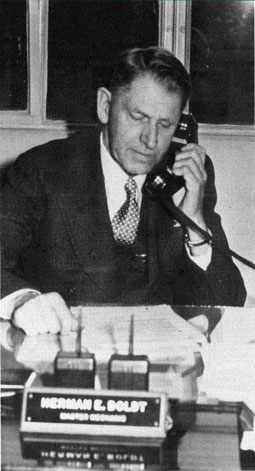|
Boy Under Instruction for Electrical Machinist: The Story of Herman Boldt
By recommendation of Assistant Secretary of the Navy, Franklin D. Roosevelt, Herman Boldt
became the first foreman to head up the Pacific Coast Torpedo Station's new power plant. When
he retired from Keyport in 1944, with 40 years government service, he was remembered for
playing a large role in the development and leadership of a torpedo station from its infancy.
Herman's life prior to coming to Keyport was similar to what you might find in a novel. He was
born in San Francisco, California, on June 12, 1885 to Herman and

Herman Boldt, shown here in later years, was a leading
figure in the development of the new torpedo station.
|
|
Augusta Boldt. The family soon moved to Seattle, but the elder Herman found his calling in the
fur trading business. With his schooner, "Seabird," he set off on an adventure to Alaska that
ended in tragedy. In 1887, Augusta received word that Herman and his crew had been massacred
by Indians.
Augusta took the younger Herman and moved to Skagit County. In 1900 the family moved again,
this time to Charleston, a town which is now part of Bremerton.
In 1901 Herman enlisted in the Navy as a Third Class Apprentice on the USS Nipsic. His career
in the Navy took a sudden twist as he was discharged soon after for a physical disability. But
that
twist was all Herman needed to make a move into what would be the most important step in his
career as an electrician.
Herman soon went to work at the Puget Sound Navy Yard in Bremerton. His title was, simply,
"Boy Under Instruction for Electrical Machinist," an apprenticeship of sorts.
Herman took several jobs using his electrical training before being appointed as Foreman
Machinist of the Power Plant and Maintenance at the U.S. Naval Station, Guam.
While in Guam, he supervised the installation of the first electrical light plant and electrical
distribution in Agana, a city that, before that time, had used kerosene to light its homes and
streets.
In September 1911, Herman married Mable Gowdy of Charleston (Bremerton). She joined him
in Guam and they were married at the Governor's Palace by Captain G.R. Salisbury, USN,
Governor of Guam and Commandant of the Naval Station.
After three years, she returned to the United States, because their son was ill. Herman's desire
to be with his family prompted him to write a letter in 1916 to the Commandant of the Puget
Sound Navy Yard. He had heard of the up and coming torpedo station at Keyport and requested to
be assigned there as Foreman of the Power Plant.
Herman soon received orders from Assistant Secretary of the Navy, Franklin D. Roosevelt, to
report to Keyport to supervise the construction and installation of the power plant and other
Station facilities.
When he arrived on June 22, 1916, the Station consisted of only one permanent building (No.
1), and approximately 30 employees. He set right to work, bringing electrical power to the
Pacific Coast Torpedo Station.

|